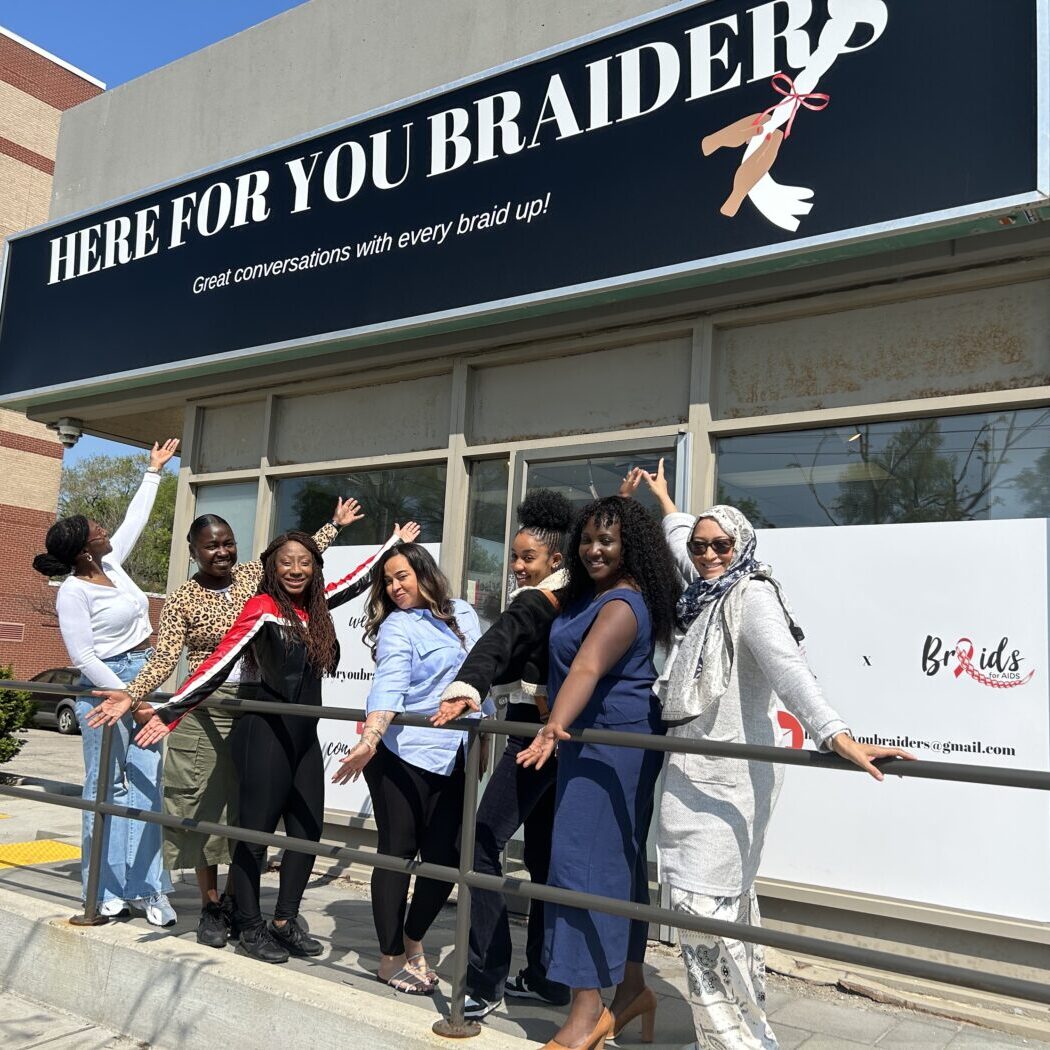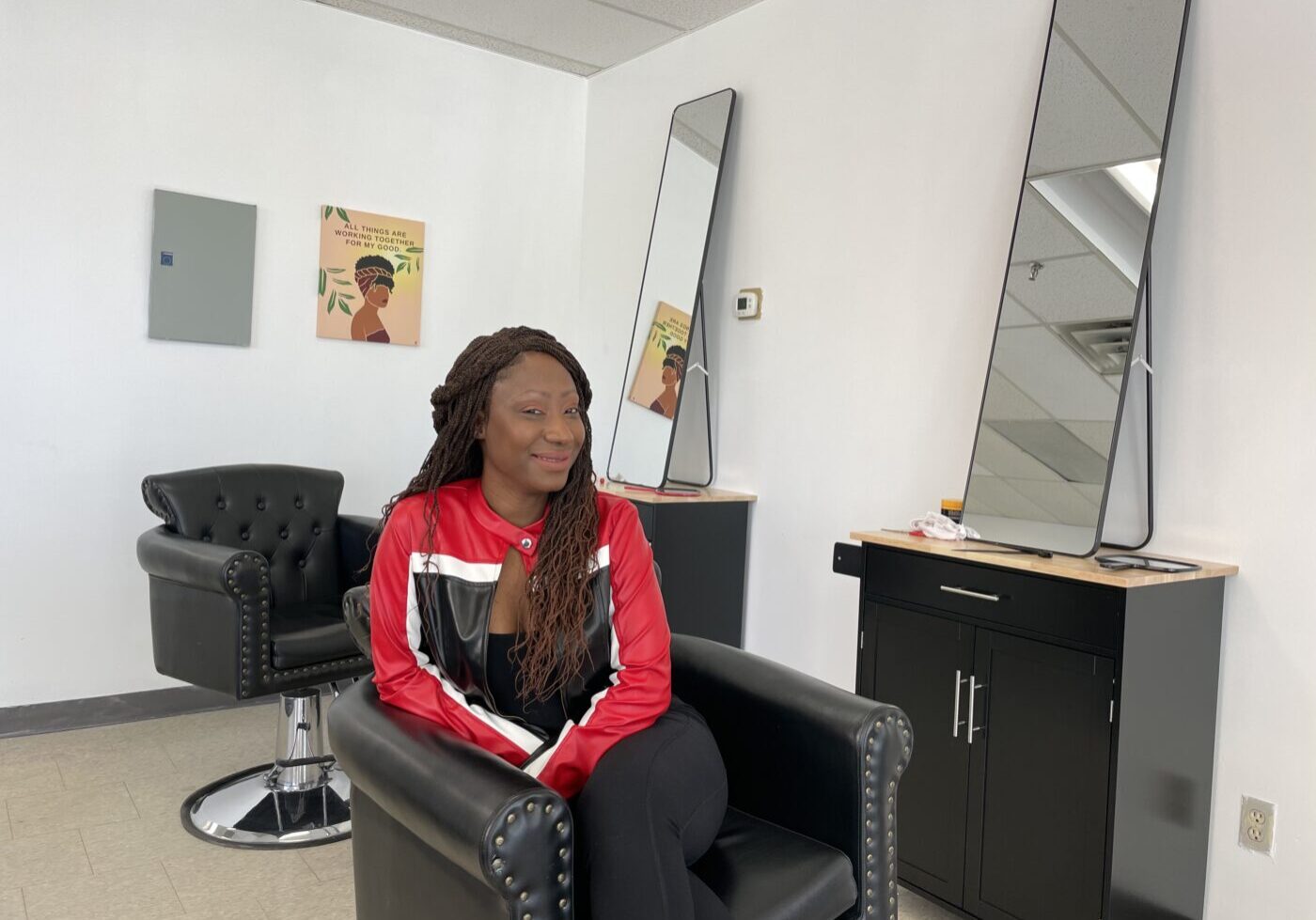THE GREEN LINE
ORIGINAL STORY
KEELESDALE-EGLINTON WEST's NEWEST BRAIDING SALON WEAVES IN SEXUAL HEALTH CONVERSATIONS FOR BLACK COMMUNITY
The Green Line team visited the neighbourhood just south of Little Jamaica to learn how Here For You Braiders is spreading awareness about HIV and AIDS among locals.

The BrAIDS for AIDS team stands in front of their first brick-and-mortar salon location in Keelesdale-Eglinton West.


ANEESA BHANJI
Currently a journalism student at Toronto Metropolitan University who's also studying communication and design. Grew up in Vaughan, now living in downtown Toronto. Always loves a good chai latte.

AMANDA SERAPHINA JAMES RAJAKUMAR
Indian immigrant with a post-grad in journalism from Centennial College. Now living in Grange Park, meeting new people, and hearing different stories. Has four names, so it’s a pick-your-player situation.
May 31, 2024
For many African, Caribbean and Black communities, braiding is part of their self-care routine.
That’s why a new salon in Keelesdale-Eglinton West is putting a twist on the braiding experience by weaving in conversations about mental and sexual health.
The neighbourhood sits just south of Little Jamaica, which is located on Eglinton Avenue West, from Marlee Ave to Keele Street. Residents know Keelesdale-Eglinton West for its Jamaican takeout spots, West Indian grocery stores and local beauty shops, including a new salon called Here For You Braiders.
Here For You Braiders is run by a community organization called BrAIDS for AIDS. It’s their first brick-and-mortar location, which will officially launch on June 2, 2024.

Stachen Lett-Frederick, owner of Here For You Braiders, stands in front of her new salon.

“Whether it be HIV/AIDS, whether it be mental health, whether it be physical health, we see that Black populations are being systematically discriminated against within the health care system,” says Stachen Lett-Frederick, the salon owner and founder of BrAIDs for AIDS.
“Many people do not have trust in some other service providers that are out there. And so, this particular salon is allowing for people to get access to information and that…could connect them to resources that are culturally relevant that can truly support them.”

Graphic showing the proportion of Ontarians living with HIV, according to the Black Coalition for AIDS Prevention.

The Black Coalition for AIDS Prevention says one in five Ontarians living with HIV are African, Caribbean or Black. But they only make-up one in 20 of Ontario’s overall population.
Lett-Frederick says this is one of the reasons why she decided to open Here For You Braiders in Keelesdale-Eglinton West. “It's very close to Little Jamaica and even in this particular community, there are a number of Black individuals and very high populations of new immigrants [so I] wanted this space again to be a space for the Black community,” she explains.
“We could have gone into Scarborough; we could have gone into many different places, but we felt that in these communities, there's a lack of access to some culturally relevant resources.”
Here For You Braiders will act as a “connector” for the local community, Lett-Frederick adds. “We don't want to be clinical social workers. We don't want to be licensed psychologists. It's more about connecting our Black community to the right resources.”

Patricia Francis-Ransome getting ready to braid at Here For You Braiders salon.

Patricia Francis-Ransome, who’s been part of BrAIDs for AIDS’ braiding team since 2019, develops close relationships with her clients.
“I say this as a joke, but I probably know more about clients than their therapists do,” she says. “I don't know what it is about hairstylists being in someone's head. It's like the most protected part of our body. So, once a hairstylist goes in there and they're caring and nurturing you, it's easy to just open up.”

Stacy Savary sitting in a salon chair at Here For You Braiders.

Stacy Savary, who’s been getting her hair done at BrAIDs for AIDS pop-up events for a decade, has felt a strong sense of community in the salons since she was a kid.
“My mom used to bring me to the salon all the time and I used to sit there and again, I'd listen to the conversations. And instead of reading a Teen Vogue magazine or watching a YouTube channel, you get the insight of really what's happening with the sisters, with the moms, with the aunts,” Savary explains.
“And also, lots of talks of relationships on how to deal with certain situations, right? Especially today, I find there's not really good go-to advice in terms of growing up and going through those stages of womanhood and puberty. But for me, that's where I took wise counsel and learned from the mistakes and also from the people around me.”
Fact-Check Yourself
Sources and
further reading
Don't take our word for it —
check our sources for yourself.
